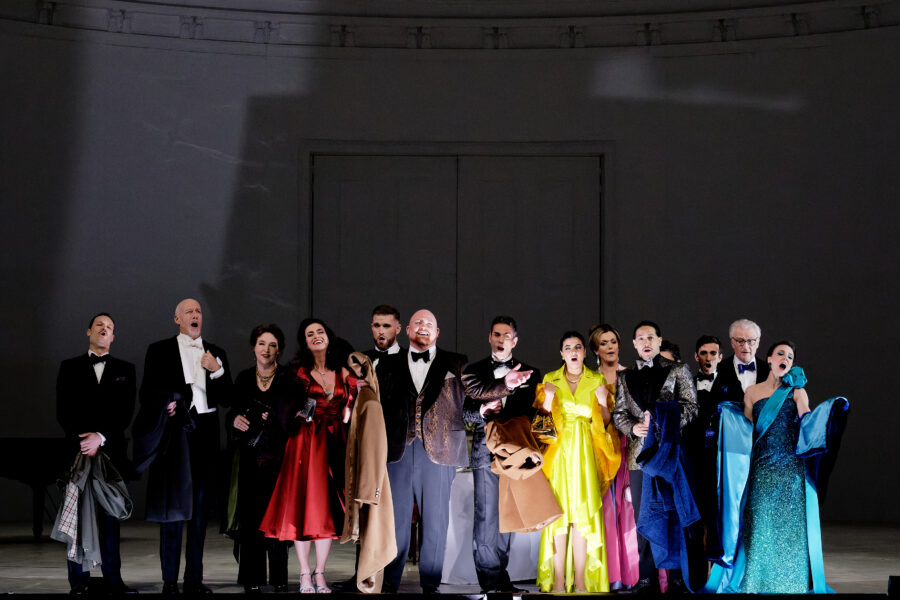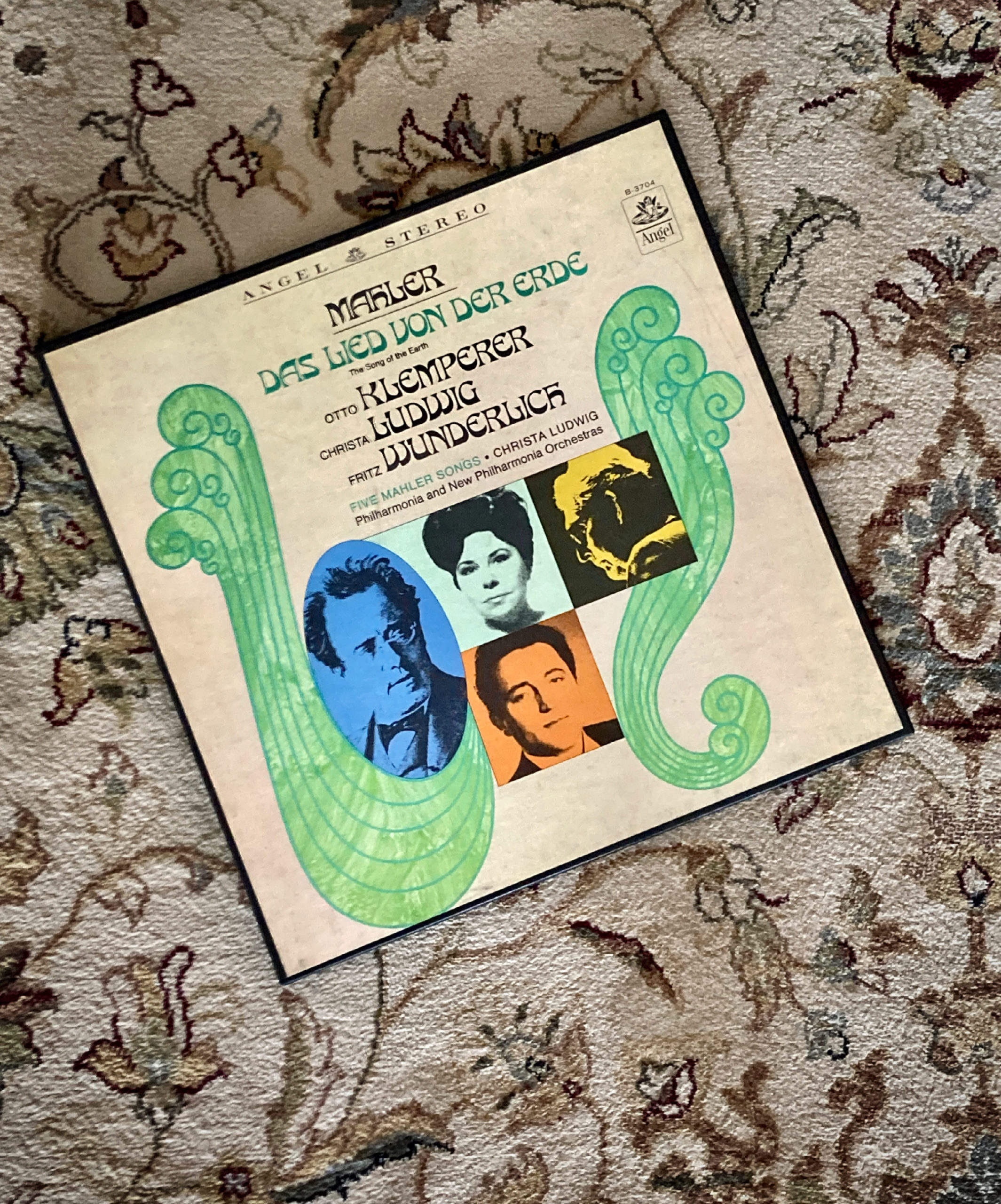Independence is as important to art as it is to life. In adapting from screen to stage, that autonomy takes on special significance. Audiences often expect a familiarity which has been molded by filmic elements and reinforced in the digital era by quick, easy access. Many works become little more than 2-D images made three-dimensional; designs serve to imitate cinema, not live apart from it. The expectation attached to adaptation, is a clear and present danger, if also a ripe creative possibility; x-ray vision is needed for 3D presentation. It helps to have a good partner.
Composer Thomas Ades and director Calixto Bieito use their combined powers to bring Ades’ 2016 opera The Exterminating Angel to startling, autonomous life. Based on the 1962 Luis Buñuel film classic, the new production at Opéra national de Paris is an unapologetic stage beast that takes aim at everything from religion to family to art to opera itself. It is bawdy, bold, and brilliant. Bieito skillfully navigates the imprecise nature of the plot by plumbing the depths of its various scenes and character relationships. The work depicts a group of aristocrats who gather for a late dinner party and can’t seem to (or won’t, possibly) depart from it. Rich in symbolic possibility, the opera’s Salzburg premiere was directed by the opera’s librettist, Tom Cairns, and went on to be staged in London and New York. Cairns’ staging hewed close to Buñuel’s visual palette of mid-20th century aristocratic Europe, a world of crepe dresses, statement jewelry, roller-set hair, as well as a thick wall between that high society and the outside world, which includes members of an inquisitive media, police, and a curious crowd. Bieito’s production is a different, and far more visceral vision. There are no live sheep here, and no thick wall either. Instead, members of the chorus (that raucous public on the other side of the earlier wall, here led by chorus master Ching-Lien Wu) are in the top tier of the Opéra Bastille, their voices floating out across the auditorium, a heavenly-hellish host of would-be angels, set to exterminate all within earshot.
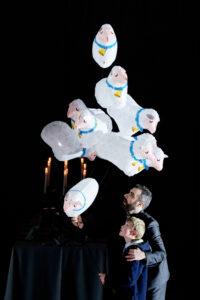
Photo: Agathe Poupeney
The production opens with a small boy holding sheep-shaped balloons wandering onstage and offering halting bleats before being joined by a priest (Régis Mengus) who whispers something close (too close) to his ear; this, we later learn, is Yoli, the son of a dinner party guest, Silvia (Claudia Boyle), who may or may not be aware of the priest’s abuses but seems determined to ignore them. Her twisted love-hate relationship with brother Francisco (Anthony Roth Costanzo) reveals a vein of wider familial abuse and reinforced silence, recurring themes within Bieito’s oeuvre. Scenes from the film are clarified with varying degrees of tension: the arrival; the ragout; the musical performances; the sister-brother fight(s); eating the sheep; the double suicide; finding water. These chapters are punctuated by highly memorable images, including the performers directly facing the audience at the arrival (echoed at the close); the ragoût consisting of two large bags of blood; the servants ducking under the table; the sheep being the guests wrapped in sheepskin rugs. Opera singer Leticia Meynar (Gloria Tronel) stands on the long wooden dining table at one point, arms aloft, holding cutlery in each hand. The table is carried by the male members of the cast around in a circle, Easter-procession style, as Ades’ score blazes out from the pit, deliciously eerie ondes Martenot included, a smouldering requiem with clear traces of Berg, Britten, Stravinsky.
Ades has tread the damnation-salvation waters previously, notably in the chamber opera Powder Her Face (1995), which explores the salacious life of Margaret Campbell, Duchess of Argyll. Music writer Alex Ross noted in a 1998 review that the work bears “a repeated sense of a beautiful mirage shattering into cold, alienated fragments.” These fragments have been enlarged within the writing of The Exterminating Angel. With the Paris iteration, they’ve also become technicolour. The depictions of not only religious ritual, but masturbation, voyeurism, defecation, self-harm, and suggested cannibalism have clear dramaturgical intent and theatrical urgency. The upright doctor of the film becomes a shambolic mess live, with a shirtless Clive Bayley joining the other cast members in shambolic disarray. Sexually voracious Lucia di Nobile (Jacquelyn Stucker) is initially elegant in a low-cut red satin dress and wavy hair; by evening’s end she is in naught but underthings, with wet hair, messy red lipstick and manic grin, looking less socialite than avenging Joker. Starlet soprano Meynar is one of the last to remove her dress (a sparkling sea-foam design) but the first to recognize the importance of the ritual that will end the group’s self-imposed situation. Performing, it turns out, is the double mirror revealing the waving man at the very back – it might be an illusion, but it’s an illusion to indulge. Indulgence also comes with a repeat of the crucifixion imagery, when the dinner party guests turn on their host, Edmundo de Nobile (Nicky Spence), blaming him for their entrapment; Nobile, as with Meynar earlier, becomes Christ-like, but the question remains: is this conviction, sacrifice, selfishness, or (quite literally) performance? What do we want as an audience – deliverance or diversion?
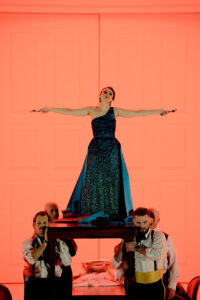
Photo: Agathe Poupeney
In presenting the group in a range of vivid colours (costume design by Ingo Krügler) set against an all-white backdrop (set design by Anna-Sofia Kirsch), the work’s relationships as well as individual foibles are both clarified and scrutinized. This clarification of structure has a direct effect on the delivery of the work’s score and performances, which are uniformly strong. The cast handles the pitchy nature of the score with dramatic aplomb and Ades’ conducting is equally precise, whether he’s leading the work’s doomed lovers, Beatriz (Amina Edris) and Eduardo (Filipe Manu) in one of the few lyrical moments of the opera, a lewd pseudo-baptism, or the work’s haunting final call, “libera de morte aeterna et lux aeterna luceat”. The lines are a fusion of a responsory sung in the Catholic Office of the Dead and Requiem Mass, respectively, with the final lines of the Libera Me particularly applicable to Bieito’s staging:
That day, day of wrath, calamity and misery, day of great and exceeding bitterness,
When thou shalt come to judge the world by fire.Rest eternal grant unto them, O Lord: and let light perpetual shine upon them.
The work ends with the cast standing as they began, assembled in a row downstage, staring at the audience in silence. Are they us? Are we them? The Exterminating Angel asks opera-goers to consider what we want, and expect – from entertainment, art, faith – and where and how they all meet. Let the light shine, suggests Bieito, but always remember the darkness. That’s where the ugly truth lies.
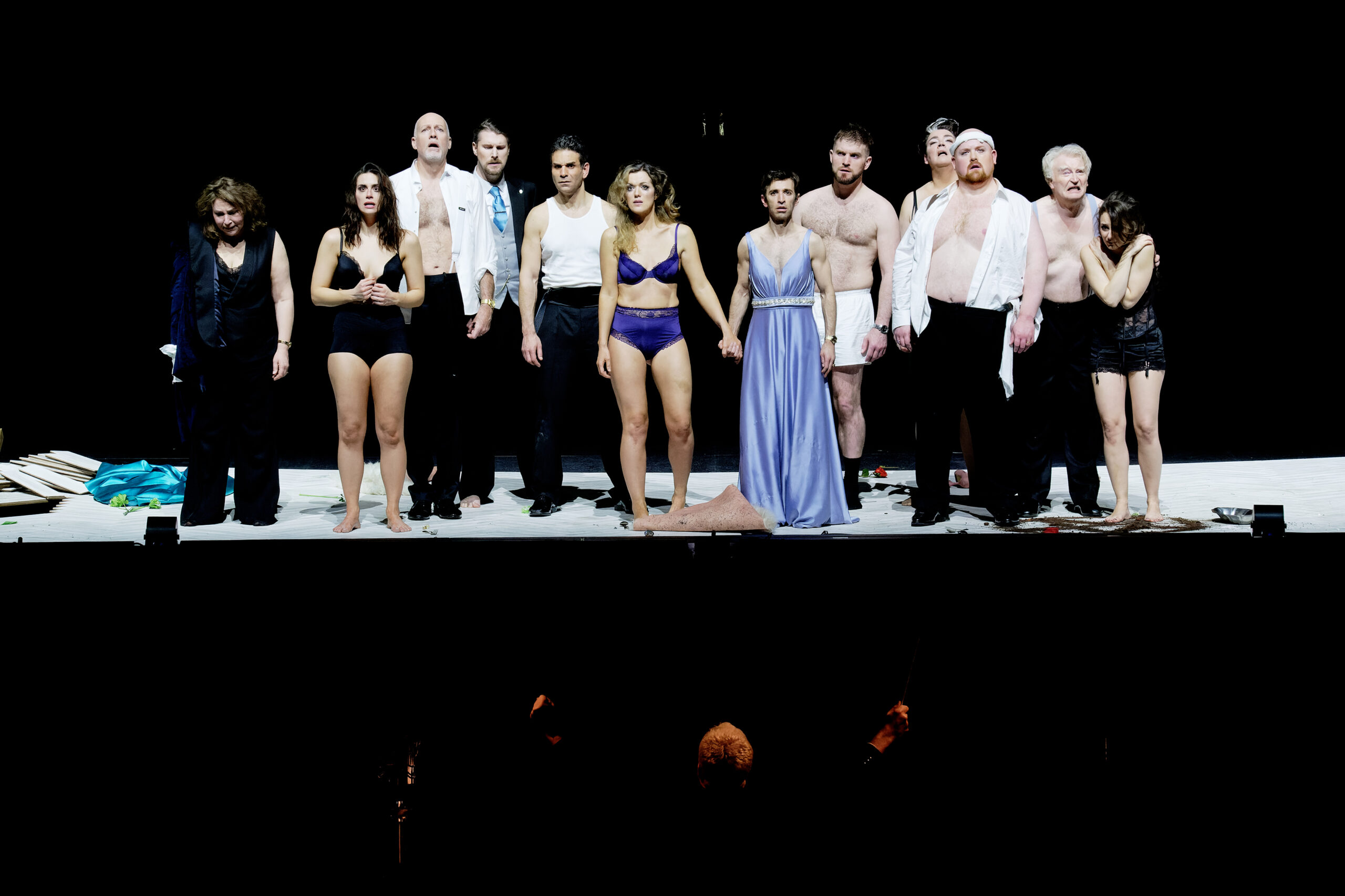
The cast of The Exterminating Angel, Opéra national de Paris, 2024. Photo: Agathe Poupeney

